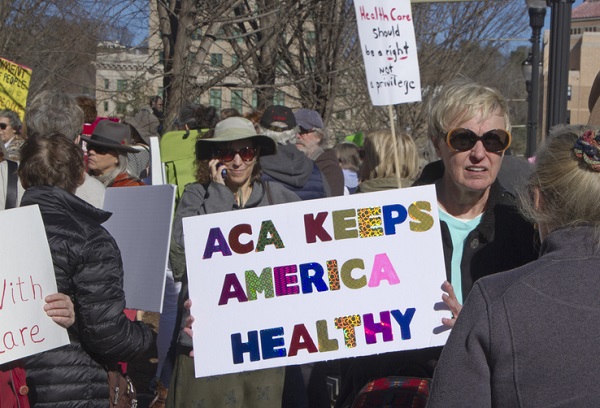 The administration,frustrated that Congress did not repeal the law, say some criticsand policy experts, is working to undermine it by weakening themarketplaces and the law's consumer protections. (Photo:Shutterstock)
The administration,frustrated that Congress did not repeal the law, say some criticsand policy experts, is working to undermine it by weakening themarketplaces and the law's consumer protections. (Photo:Shutterstock)
In the span of less than 12 hours last week, the Trumpadministration took two seemingly contradictory actions that couldhave profound effects on the insurance marketplaces set up by the AffordableCare Act.
|First, officials issued guidance Monday morning that could weaken the exchangesset up for people who buy their own insurance. The new approachmakes it easier for states to get around some ACA requirements, including allowing the use offederal subsidies for skimpier plans that can reject people withpreexisting conditions.
| Related: GOP candidates sprinting away from ACArepeal
Related: GOP candidates sprinting away from ACArepeal
Yet, the other move — a proposedrule unveiled Monday evening — could bolster ACA marketplacesby sending millions of people with job-based coverage there, armedwith tax-free money from their employers to buy individualplans.
|Both efforts play into the parallel narratives dominating thebitter political debate over the ACA.
|The administration, frustrated that Congress did not repeal thelaw, say some critics and policy experts, is working to undermineit by weakening the marketplaces and the law's consumerprotections. Those efforts make it easier for insurers to offerskimpier policies that bypass the law's rules, such as its ban onannual or lifetime limits or its protections for people withpreexisting conditions. Congress also zeroed out the tax penaltyfor not having coverage, effective next year. Combined, the movescould reduce enrollment in ACA plans, potentially driving uppremiums for those who remain.
|The administration and Republicans in Congress say they arelooking to assist those left behind by the ACA — people who don'tget subsidies to help them buy coverage and are desperate for lessexpensive options — even if that means purchasing less robustcoverage.
|“These are people who were buying insurance before [the law] andthen the rules changed and they could not buy it because they couldnot afford it,” said Joe Antos, a resident scholar at theconservative American Enterprise Institute. “They have been slowlydropping out of insurance coverage altogether.”
|The efforts are dramatically reshaping the ACA and theindividual insurance market to one that looks more as it did beforethe 2010 law, when regulation, coverage and consumer protectionsvaried widely across the country.
|“Some states will do everything they can to keep individualmarkets strong and stable. Others won't,” said Sabrina Corlette,research professor at the Center on Health Insurance Reforms atGeorgetown University.
|So what expectations should consumers have? Here are three keytakeaways:
|Protections for preexisting health problems are uncertain.
|Polls show that keeping the ACA's guarantees on coverage forpeople with medical problems is a top concern for Americans, andDemocrats have made their defense of the health law a key part oftheir midterm election campaigns.
|Republicans have gotten that message and even those who voted torepeal the ACA or joined a lawsuit by 20 red states to overturn itnow say they want to protect people with preexisting conditions.Still, GOP lawmakers have not introduced any plan that would be asprotective as the current law.
|In August, the administration released a rule allowing expandeduse of short-term plans, which are less expensive than ACApolicies. To get those lower prices, most of these plans do notcover prescription drugs, maternity care, mental health orsubstance abuse treatments.
|The move is unlikely to benefit people with health problems, asshort-term plans can reject people with preexisting conditions ordecline to cover care for those medical problems.
|Under the rule, insurers can sell them starting in 2019 for upto a year's duration, with an option to renew for up to threeyears, reversing an Obama-era directive that limited them to 90days.
|Administration officials estimate such plans could draw 600,000new enrollees next year, and others have estimated the numberscould be far higher. The concern is if many healthy people in 2019switch out of the ACA market and choose short-term plans, premiumswill rise for those who remain, including those with preexistingconditions or make the ACA market less attractive for insurers.
|Where you live matters more.
|One of the biggest changes ushered in with the ACA was astandard set of rules across all states.
|Before the law took effect, consumers buying their own coveragesaw tremendous variation in what was offered and what protectionsthey had, depending on the state where they lived.
|Most states, for example, allowed insurers to reject people withmedical conditions. A few states required insurers to chargesimilar premiums across the board, but most allowed wide variationsbased on age, gender or health. Some skimpy plans didn't coverprescription drugs, chemotherapy or other medical services.
|By standardizing the rules and benefits, the ACA barred insurersfrom rejecting applicants with medical conditions or charging themmore. Women and men get the same premium rates and insurers couldcharge older people no more than three times what they chargedyounger ones.
|Under the new guidance issued this week giving states moreflexibility on what is offered, consumers could again see a widevariation on coverage, premium rules and even subsidyeligibility.
|“It shifts pressure to state politicians,” said CarolinePearson, a senior fellow at NORC, a nonpartisan researchinstitution at the University of Chicago. That could play into thecalculus of whether a state will seek to make broad changes to helppeople who cannot afford ACA plans, even if the trade-off affectspeople with medical conditions.
|“You risk making some worse off by threatening those markets,”said Pearson. “That is always going to be hard.”
|Millions more will join the “buy-your-own” ranks.
|The proposed rule released Tuesday allows employers to fundtax-free accounts — called health reimbursement arrangements (HRAs)— that workers can use to buy their own coverage on the ACAmarketplaces.
|The administration estimates about 10 million people would do soby 2028 — a substantial boost for those exchanges, whichpolicymakers say never hit the enrollment numbers needed to attractenough insurers and hold prices down.
|John Barkett, senior director of policy affairs at Willis TowersWatson, a benefits consulting firm, said he expects employers to“seriously consider” the new market. The infusion of workers willimprove options by attracting more insurers, he added.
|“These people coming in will be employer-sponsored, they'll havesteady jobs,” Barkett noted, and will likely stick with coveragelonger than those typically in the individual market.
|Currently more than 14 million people buy their own insurance,with about 10 million of those using federal or state ACAmarketplaces. The others buy private plans through brokers.
|The proposed rule won't be finalized for months, but it couldresult in new options by 2020.
|If these workers seeking coverage are generally healthy, theinfusion could slow premium increases in the overall ACAmarketplace because it would improve the risk pool forinsurers.
|But, if employers with mainly higher-cost or older workers optto move to the marketplaces, it could help drive up premiums.
|In an odd twist, the administration notes in the proposed rulethat the ACA has provisions that could protect the marketplace fromthat type of adverse selection, which can drive up prices. But mostof the protective factors cited by the rule have been weakened,removed or expired, such as the tax penalty for being uninsured andthe federal subsidies for insurers to cover lower deductibles forcertain low-income consumers.
|Benefits consultants and policy experts are skeptical about howmany companies will move to the HRA plan, given the tight labormarket. Continued uncertainty about the fate of the ACA marketplacemay keep them reluctant to send workers out on their own, theysay.
|Health benefits are a big factor in attracting and retainingworkers, said Chris Condeluci, a Washington attorney who previouslyworked for Sen. Chuck Grassley (R-Iowa) and served as counsel tothe Senate Finance Committee during the drafting of the ACA.
|“Most employers believe their group health plan will providebetter health coverage than an individual market plan,” hesaid.
|Kaiser Health News isa nonprofit news service covering health issues. It is aneditorially independent program of the Kaiser Family Foundation,which is not affiliated with Kaiser Permanente.
|Read more:
- The dismantling of the ACA: Atimeline
- McConnell defends Texas ACA lawsuit, looks forwardto new repeal efforts
- 7 facts about the new ACA waiver program, foragent
Complete your profile to continue reading and get FREE access to BenefitsPRO, part of your ALM digital membership.
Your access to unlimited BenefitsPRO content isn’t changing.
Once you are an ALM digital member, you’ll receive:
- Critical BenefitsPRO information including cutting edge post-reform success strategies, access to educational webcasts and videos, resources from industry leaders, and informative Newsletters.
- Exclusive discounts on ALM, BenefitsPRO magazine and BenefitsPRO.com events
- Access to other award-winning ALM websites including ThinkAdvisor.com and Law.com
Already have an account? Sign In
© 2024 ALM Global, LLC, All Rights Reserved. Request academic re-use from www.copyright.com. All other uses, submit a request to [email protected]. For more information visit Asset & Logo Licensing.








